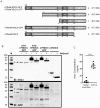Evidence against a beneficial effect of irisin in humans
- PMID: 24040023
- PMCID: PMC3770677
- DOI: 10.1371/journal.pone.0073680
Evidence against a beneficial effect of irisin in humans
Abstract
Brown adipose tissue has gained interest as a potential target to treat obesity and metabolic diseases. Irisin is a newly identified hormone secreted from skeletal muscle enhancing browning of white fat cells, which improves systemic metabolism by increasing energy expenditure in mice. The discovery of irisin raised expectations of its therapeutic potential to treat metabolic diseases. However, the effect of irisin in humans is unclear. Analyses of genomic DNA, mRNA and expressed sequence tags revealed that FNDC5, the gene encoding the precursor of irisin, is present in rodents and most primates, but shows in humans a mutation in the conserved start codon ATG to ATA. HEK293 cells transfected with a human FNDC5 construct with ATA as start codon resulted in only 1% full-length protein compared to human FNDC5 with ATG. Additionally, in vitro contraction of primary human myotubes by electrical pulse stimulation induced a significant increase in PGC1α mRNA expression. However, FNDC5 mRNA level was not altered. FNDC5 mRNA expression in muscle biopsies from two different human exercise studies was not changed by endurance or strength training. Preadipocytes isolated from human subcutaneous adipose tissue exhibited differentiation to brite human adipocytes when incubated with bone morphogenetic protein (BMP) 7, but neither recombinant FNDC5 nor irisin were effective. In conclusion, our findings suggest that it is rather unlikely that the beneficial effect of irisin observed in mice can be translated to humans.
Conflict of interest statement
Figures





References
-
- Lyon HN, Hirschhorn JN (2005) Genetics of common forms of obesity: a brief overview. Am J Clin Nutr 82: 215S–217S. - PubMed
-
- Velho G, Robert JJ (2002) Maturity-onset diabetes of the young (MODY): genetic and clinical characteristics. Horm Res 57 Suppl 129–33. - PubMed
-
- Naik RG, Brooks-Worrell BM, Palmer JP (2009) Latent autoimmune diabetes in adults. J Clin Endocrinol Metab 94: 4635–4644. - PubMed
-
- James W, Jackson-Leach R, Mhurchu CN, Kalamara E, Shayeghi M, et al... (2003) Overweight and obesity (high body mass index). Comparative Quantification of Health Risks: Global and Regional Burden of Disease Attributable to Selected Risk Factors Geneva, World Health Org.: 497–596.
-
- Cannon B, Nedergaard J (2004) Brown adipose tissue: function and physiological significance. Physiol Rev 84: 277–359. - PubMed
Publication types
MeSH terms
Substances
LinkOut - more resources
Full Text Sources
Other Literature Sources
Molecular Biology Databases
Research Materials

